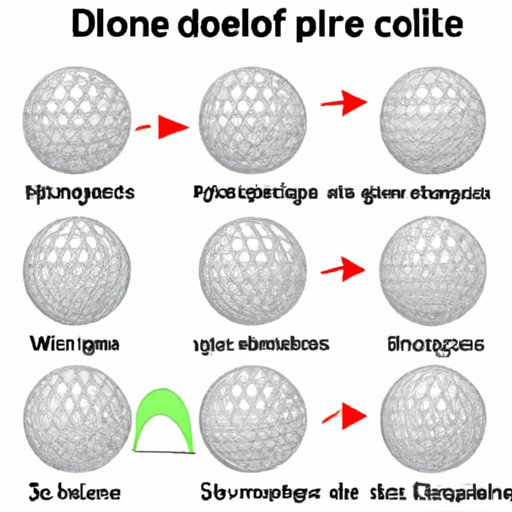Introduction
Golf is a sport that requires precision and skill. From driving off the tee to sinking long putts, every shot counts. But did you ever stop to wonder why golf balls have dimples? In this article, we’ll explore the physics of dimpled golf balls, uncover their benefits for golfers, examine their historical context, and analyze their aerodynamic effects.
Exploring the Physics of Dimples on a Golf Ball
At first glance, it may seem counterintuitive that a golf ball with dimples would fly farther than one without them. After all, aerodynamic drag is the force that opposes an object’s motion through air or water. And a smooth surface should reduce drag, right? Let’s take a look at how dimples affect a golf ball’s flight.
The Role of Air Resistance
Air resistance is the force that acts on a golf ball as it travels through the air. This force reduces the speed of the ball, which in turn reduces the distance it can travel. In order to maximize distance, golfers must minimize air resistance as much as possible.
How Dimples Create Lift and Reduce Drag
Dimples on a golf ball are designed to create lift and reduce drag. The dimples create turbulence in the air around the ball, which helps keep it in the air longer. This turbulence also reduces the amount of air resistance acting on the ball, allowing it to travel farther.
The Impact of Spin on Flight
Spin plays an important role in the trajectory of a golf ball. When a ball is struck with backspin, it creates a higher pressure area on the bottom of the ball and a lower pressure area on the top. This difference in pressure creates lift, which helps the ball stay in the air for a longer period of time.

Uncovering the Benefits of Dimpled Golf Balls
Now that we understand the physics behind dimples on golf balls, let’s take a look at the benefits they offer. Dimpled golf balls provide golfers with improved distance, more accurate shots, and enhanced feel.
Improved Distance
One of the most obvious benefits of dimpled golf balls is improved distance. By reducing drag and increasing lift, dimples allow the ball to travel farther with less effort. This makes it easier for golfers to hit longer shots and reach the green in fewer strokes.
More Accurate Shots
In addition to improved distance, dimpled golf balls also offer greater accuracy. Dimples help stabilize the ball’s flight path, making it easier to hit straight shots and avoid errant shots. This can help golfers shave strokes off their scores and play better golf.
Enhanced Feel
Finally, dimpled golf balls provide improved feel. The dimples help generate spin, which gives golfers greater control over their shots. This makes it easier to shape shots and land the ball on the green with pinpoint accuracy.

Examining the History of Dimpled Golf Balls
The modern golf ball has come a long way since its early beginnings. Let’s take a look at the evolution of dimpled golf balls.
Early Beginnings
The earliest golf balls were made from hardwood and leather. These balls had little to no dimples and provided limited distance and accuracy. As technology improved, manufacturers began experimenting with different materials, such as gutta-percha and balata.
Evolution of Modern Golf Ball Designs
By the late 19th century, golf balls were made from rubber and had a smooth, uniform surface. It wasn’t until the 1930s that golf balls began to feature dimples. Today, dimpled golf balls are the standard, offering golfers improved performance and greater control.
Investigating the Aerodynamic Effects of Dimpled Golf Balls
Now that we’ve explored the history of dimpled golf balls, let’s examine how they affect aerodynamics. To do this, we need to understand the role of pressure differentials and the impact of turbulence.
Understanding the Role of Pressure Differentials
As a golf ball moves through the air, it creates a difference in air pressure between the front and back of the ball. This difference in pressure is known as a pressure differential. The greater the pressure differential, the more lift the ball will generate, which helps it stay in the air longer.
Examining the Impact of Turbulence
Dimples on a golf ball create turbulence in the air around the ball. This turbulence helps reduce the amount of air resistance acting on the ball, resulting in improved distance. It also helps generate lift, allowing the ball to stay in the air longer and travel farther.

Analyzing the Design Advantages of Dimpled Golf Balls
Dimpled golf balls offer several design advantages, including optimizing the coefficient of restitution, maximizing spin rate and control, and improving feel.
Optimizing the Coefficient of Restitution
The coefficient of restitution (COR) measures how much energy is lost when a golf ball strikes a club face. A higher COR means less energy is lost, resulting in increased distance. Dimples on a golf ball help optimize the COR, allowing golfers to maximize their distance.
Maximizing Spin Rate and Control
Dimples also help maximize spin rate and control. The dimples create turbulence, which helps the ball generate more spin. This spin helps golfers shape shots and increase accuracy. It also helps golfers control the trajectory of the ball, making it easier to hit straight shots.
Conclusion
From improved distance to enhanced feel, dimpled golf balls offer a variety of benefits for golfers. By understanding the physics of dimpled golf balls, we can see how they help reduce drag and create lift. We can also appreciate their design advantages, such as optimizing the coefficient of restitution and maximizing spin rate and control. With these insights, golfers can make better choices when selecting a golf ball.


